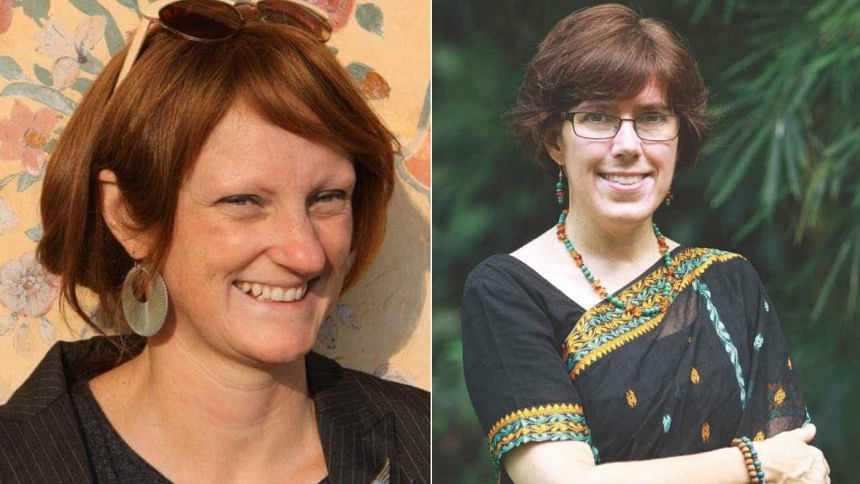Contemporary Dissent – Echoes of the 80’s

In the podcast episode, 'Contemporary Dissent – Echoes of the 80's' by "Chobi Mela Shunno'', Lotte Hoek and Catherine Masud share their experiences, looking back at their journeys in the late 1980's and early 2000's in Bangladesh. They talk about the parallels and differences in their journeys.
Catherine Masud is an award-winning filmmaker with over 30 years of experience in producing, directing and editing both documentary and fictional genres. She produced, co-wrote, and edited the acclaimed feature "Matir Moina" (The Clay Bird), which won the International Critics' Prize at Cannes and became the first Bangladeshi film to compete in the Oscars.
Lotte Hoek is a media anthropologist whose ethnographic research explores cultures of the moving image in South Asia, particularly in Bangladesh. Her current research focuses on art film and non-theatrical exhibitions as grounds for political contestation in Bangladesh since 1948. She is also the author of Cut-Pieces: Celluloid Obscenity and Popular Cinema in Bangladesh, which explores the nature of film form in the popular film industry.
"When I first came to Bangladesh, there was extreme political volatility all around, but at the same time the culture and its aspects were very dynamic and fascinating," shares Catherine. "I was attracted to those particular circles of writers, painters, filmmakers and photographers among others; the artiste's participation and engagement in the society was a completely new experience for me."
She further talks about the Short Film Movement of the 80's and the first edition of Dhaka International Short & Documentary Film Festival as the pivotal point in the evolution of independent cinema in Bangladesh. "Young group of filmmakers was going out of their comfort zone, making films with their own resources and then showing these films on their own process. These had a significant impact on the movement," she says. "It is powerful to see the films engage the society, the moving image was hardwired in the aspect of raising public consciousness."
She shares intimate anecdotes from her involvement in the making, distribution and exhibition of films like "Muktir Gaan", which was directed by Tareque Masud and Catherine Masud. "It was a tremendous struggle to release that film, we went to several cinema halls and most of them were not interested," she reminisces. "When the film started to get popular and people were interested, then the cinema owners came to us asking to show our film."
The lack of technology and resources at that time was evident in her memories. "We only had four prints of the film and we carefully decided to send one in the Cantonment Cinema Hall and one in Chattogram and Myemensingh, and then it was moved around in other places," Catherine shares.
They also share their disparate experiences of being foreigners, who engaged extensively in the world of art and visual culture in Bangladesh and how it eventually shaped their personal identities. "In the process and through my work, I became embedded with the people and the culture and internalised it in a sense. In a subconscious way, I began to see myself as a Bengali and I think others often thought of me as well," expresses Catherine. "Muktir Gaan, Mukti Kotha and all the other projects, took us into the deep rural aspects of Bangladesh and it was an outstanding experience for me."
An American citizen by birth, Catherine spent much of her adult life in Dhaka, Bangladesh, working together with her late husband and filmmaking partner Tareque Masud. Since her relocation back to the US in 2015, she has divided her time between teaching, writing, and filmmaking. She currently teaches documentary and human rights at the University of Connecticut.
Lotte further discusses the shift in the early 2000's with the advancement of technology, role of television and advertisement, crumbling cinema halls and the subsequent countervailing of independent cinema to the mainstream industry. "When I was working in Bangladesh, my partner and I were visiting different cinema halls and they were quite extraordinary," shares Lotte, Head of Social Anthropology at the University of Edinburgh. "Around the 1980's, there were so many cinema halls built and it was very profitable at the time; however, now, most of these buildings are torn down and only a few of the halls are used."
Their discussion further explores the ideas and concepts of filmmaking and how the moving image can shape the cinematic culture and the society as a whole, in a much broader sense.

 For all latest news, follow The Daily Star's Google News channel.
For all latest news, follow The Daily Star's Google News channel. 



Comments